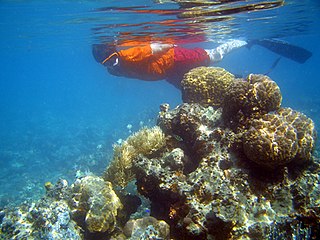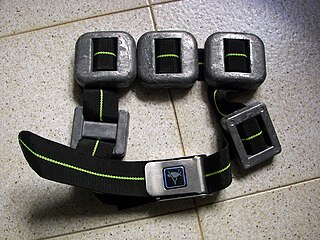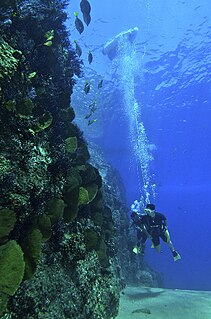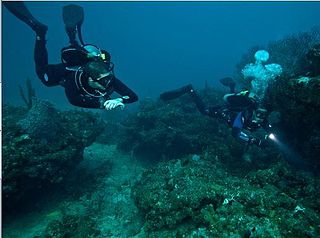
A scuba set is any breathing apparatus that is carried entirely by an underwater diver and provides the diver with breathing gas at the ambient pressure. Scuba is an anacronym for self-contained underwater breathing apparatus. Although strictly speaking the scuba set is only the diving equipment which is required for providing breathing gas to the diver, general usage includes the harness by which it is carried, and those accessories which are integral parts of the harness and breathing apparatus assembly, such as a jacket or wing style buoyancy compensator and instruments mounted in a combined housing with the pressure gauge, and in the looser sense it has been used to refer to any diving equipment used by the scuba diver, though this would more commonly and accurately be termed scuba equipment or scuba gear. Scuba is overwhelmingly the most common underwater breathing system used by recreational divers and is also used in professional diving when it provides advantages, usually of mobility and range, over surface supplied diving systems, and is allowed by the relevant code of practice.

Snorkeling is the practice of swimming on or through a body of water while equipped with a diving mask, a shaped breathing tube called a snorkel, and usually swimfins. In cooler waters, a wetsuit may also be worn. Use of this equipment allows the snorkeler to observe underwater attractions for extended periods with relatively little effort and to breathe while face-down at the surface.

A frogman is someone who is trained in scuba diving or swimming underwater in a tactical capacity that includes military, and in some European countries, police work. Such personnel are also known by the more formal names of combat diver, combatant diver, or combat swimmer. The word frogman first arose in the stage name The Fearless Frogman of Paul Boyton in the 1870s and later was claimed by John Spence, an enlisted member of the U.S. Navy and member of the OSS Maritime Unit, to have been applied to him while he was training in a green waterproof suit.

Swimfins, swim fins, diving fins, or flippers are finlike accessories worn on the feet, legs or hands and made from rubber, plastic, carbon fiber or combinations of these materials, to aid movement through the water in water sports activities such as swimming, bodyboarding, bodysurfing, float-tube fishing, kneeboarding, riverboarding, scuba diving, snorkeling, spearfishing, underwater hockey, underwater rugby and various other types of underwater diving.

A diving weighting system is ballast weight added to a diver or diving equipment to counteract excess buoyancy. They may be used by divers or on equipment such as diving bells, submersibles or camera housings.

A monofin is a type of swimfin typically used in underwater sports such as finswimming, free-diving and underwater orienteering. It consists of a single or linked surfaces attached to both of the diver's feet.

A dive boat is a boat that recreational divers or professional scuba divers use to reach a dive site which they could not conveniently reach by swimming from the shore. Dive boats may be propelled by wind or muscle power, but are usually powered by internal combustion engines. Some features, like convenient access from the water, are common to all dive boats, while others depend on the specific application or region where they are used. The vessel may be extensively modified to make it fit for purpose, or may be used without much adaptation if it is already usable.

Snuba is form of surface-supplied diving that uses an underwater breathing system developed by Snuba International. The origin of the word "Snuba" may be a portmanteau of "snorkel" and "scuba", as it bridges the gap between the two. Alternatively, some have identified the term as an acronym for "Surface Nexus Underwater Breathing Apparatus", though this may have been ascribed retroactively to fit the portmanteau. The swimmer uses swimfins, a diving mask, weights, and diving regulator as in scuba diving. Instead of coming from tanks strapped to the diver's back, air is supplied from long hoses connected to compressed air cylinders contained in a specially designed flotation device at the surface. Snuba often serves as a form of introductory diving, in the presence of a professionally trained guide, but requires no scuba certification.
Cressi is one of the largest manufacturers of water sports equipment in the world serving the scuba dive, snorkel and swim industries. The company's five divisions cover four markets—scuba diving, snorkeling, spearfishing, and swimming. Cressi maintains a significant presence in each major economic region around the globe and delivers some 300 distinct products to more than 90 countries. Formerly Cressi-Sub, the Italian company was founded by two brothers, Egidio and Nanni Cressi in 1946 in Genoa, Italy. Still family owned and operated, the company is headed today by Antonio Cressi and its headquarters and manufacturing facilities remain in Genoa.
Defenses against swimmer incursions are security methods developed to protect watercraft, ports and installations, and other sensitive resources in or near vulnerable waterways from potential threats or intrusions by swimmers or scuba divers.

Finning techniques are the skills and methods used by swimmers and underwater divers to propel themselves through the water and to maneuver when wearing swimfins. There are several styles used for propulsion, some of which are more suited to particular swimfin configurations. There are also techniques for positional maneuvering, such as rotation on the spot, which may not involve significant locational change. Use of the most appropriate finning style for the circumstances can increase propulsive efficiency, reduce fatigue, improve precision of maneuvering and control of the diver's position in the water, and thereby increase the task effectiveness of the diver and reduce the impact on the environment. Propulsion through water requires much more work than through air due to higher density and viscosity. Diving equipment which is bulky usually increases drag, and reduction of drag can significantly reduce the effort of finning. This can be done to some extent by streamlining diving equipment, and by swimming along the axis of least drag, which requires correct diver trim. Efficient production of thrust also reduces the effort required, but there are also situations where efficiency must be traded off against practical necessity related to the environment or task in hand, such as the ability to maneuver effectively and resistance to damage of the equipment.

Sidemount is a scuba diving equipment configuration which has scuba sets mounted alongside the diver, below the shoulders and along the hips, instead of on the back of the diver. It originated as a configuration for advanced cave diving, as it facilitates penetration of tight sections of cave, allows easy access to cylinder valves, provides easy and reliable gas redundancy, and tanks can be easily removed when necessary. These benefits for operating in confined spaces were also recognized by divers who conducted technical wreck diving penetrations.

Canoe diving and Kayak diving are recreational diving where the divers paddle to a diving site in a canoe or kayak carrying all their gear in or on the boat to the place they want to dive. Canoe or kayak diving gives the diver independence from dive boat operators, while allowing dives at sites which are too far to comfortably swim, but are sufficiently sheltered.

Diving equipment is equipment used by underwater divers to make diving activities possible, easier, safer and/or more comfortable. This may be equipment primarily intended for this purpose, or equipment intended for other purposes which is found to be suitable for diving use.
In underwater diving, ascending and descending is done using strict protocols to avoid problems caused by the changes in ambient pressure and the hazards of obstacles near the surface such as collision with vessels. Diver certification and accreditation organisations place importance on these protocols early in their diver training programmes.

The trim of a diver is the orientation of the body in the water, determined by posture and the distribution of weight and volume along the body and equipment, as well as by any other forces acting on the diver. Both static trim and its stability affect the convenience and safety of the diver while under water and at the surface. Midwater trim is usually considered at approximately neutral buoyancy for a swimming scuba diver, and neutral buoyancy is necessary for efficient maneuvering at constant depth, but surface trim may be at significant positive buoyancy to keep the head above water.

Scuba skills are skills required to dive safely using self-contained underwater breathing apparatus. Most of these skills are relevant to both open-circuit scuba and rebreather scuba, and many are also relevant to surface-supplied diving. Certain scuba skills, which are critical to divers' safety, may require more practice than is provided during standard recreational training.

Doing It Right (DIR) is a holistic approach to scuba diving that encompasses several essential elements, including fundamental diving skills, teamwork, physical fitness, and streamlined and minimalistic equipment configurations. DIR proponents maintain that through these elements, safety is improved by standardizing equipment configuration and dive-team procedures for preventing and dealing with emergencies.

The following outline is provided as an overview of and topical guide to underwater diving:
Philip Wellesley Dulhunty, OAM was an Australian aviator, power distribution entrepreneur and inventor. He invented the widely-adopted "dogbone" damper for the protection of overhead power lines and produced the world's first battery-powered laptop computer. He was chairman of the Australian National Committee of the Conseil International des Grands Réseaux Électriques (CIGRÉ) and a member of its international administrative council and executive committee. He formed the Seaplane Pilots Association of Australia in 1972 and was its chairman for 44 years.













